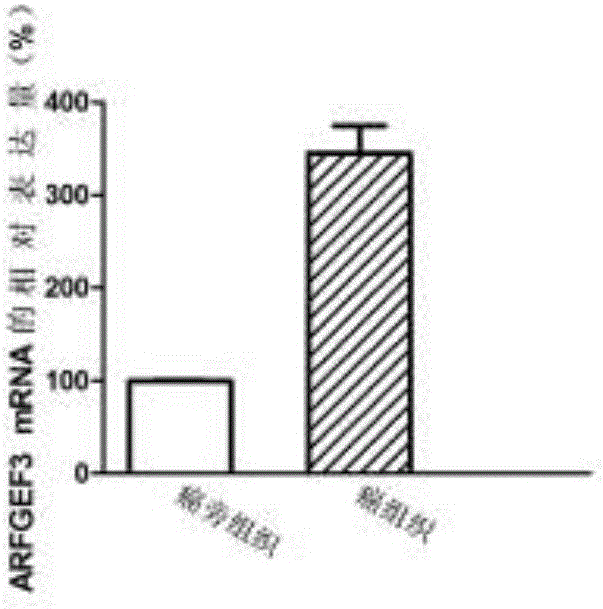Application of gene used as biomarker in colon adenocarcinoma
A colon adenocarcinoma and genetic technology, applied in the field of biomedicine, can solve the problems of poor patient compliance, early diagnosis of colon adenocarcinoma, low sensitivity and specificity, etc.
- Summary
- Abstract
- Description
- Claims
- Application Information
AI Technical Summary
Problems solved by technology
Method used
Image
Examples
Embodiment 1
[0090] Example 1 Screening for Gene Markers Related to Colon Adenocarcinoma
[0091] 1. Sample collection
[0092] The cancer tissues and paracancerous tissues of 8 patients with early colon adenocarcinoma were collected. All patients had not received radiotherapy and chemotherapy before surgery, and all patients gave informed consent. All the above specimens were obtained with the approval of the organizational ethics committee.
[0093] 2. Preparation of RNA samples
[0094] Tissue RNA was extracted using QIAGEN tissue RNA extraction kit, and the operation was performed according to the specific steps in the manual. Nanodrop2000 was used to detect the concentration and purity of the extracted RNA, agarose gel electrophoresis was used to detect RNA integrity, and Agilent2100 was used to determine the RIN value. Concentration ≥ 200ng / μL, OD260 / 280 between 1.8 and 2.2.
[0095] 3. Remove rRNA
[0096] Ribosomal RNA was removed from total RNA using the Ribo-Zero kit.
[009...
Embodiment 2
[0105] Example 2 QPCR sequencing to verify the differential expression of ARFGEF3 gene
[0106] 1. Large-sample QPCR verification of differential expression of ARFGEF3 gene. According to the sample collection method in Example 1, 60 colon adenocarcinoma tissue samples and 60 paracancerous tissue samples were collected.
[0107] 2. RNA extraction The steps are the same as in Example 1.
[0108] 3. QPCR detection:
[0109] (1) Reverse transcription reaction
[0110] Use 25μl reaction system, take 1μg total RNA for each sample as template RNA, and add the following components to PCR tubes: DEPC water, 5× reverse expression buffer, 10mM dNTP, 0.1mM DTT, 30μM Oligo dT, 200U / μl M-MLV, template RNA.
[0111] According to the reverse transcription reaction conditions in RNA PCR Kit (AMV) Ver.3.0.
[0112] (2) Polymerase chain reaction
[0113] Amplification primers for the ARFGEF3 gene and the housekeeping gene GAPDH were designed and synthesized by Sangon. The primer sequences ...
Embodiment 3
[0120] Example 3 Silencing of ARFGEF3 Gene
[0121] 1. Cell culture
[0122] Human colon adenocarcinoma cell line SW480, at 37°C, 5% CO 2 , cultured in an incubator with a relative humidity of 90%, using medium RPMI-1640 containing 10% fetal bovine serum and 1% P / S. Use well-grown cells for experiments.
[0123] 2. siRNA design
[0124] siRNA sequence against ARFGEF3 gene:
[0125] Negative control siRNA sequence (siRNA-NC):
[0126] Sense strand: 5'-UUCUCCGAACGUGUCACGU-3' (SEQ ID NO.5),
[0127] Antisense strand: 5'-ACGUGACACGUUCGGAGAA-3' (SEQ ID NO.6);
[0128] siRNA1:
[0129] Sense strand: 5'-AUCAGAAUCUGUUUCCAUGGA-3' (SEQ ID NO.7),
[0130] Antisense strand: 5'-CAUGGAAACAGAUUCUGAUGA-3' (SEQ ID NO.8);
[0131] siRNA2:
[0132] Sense strand: 5'-ACUAUACCUAGAUCCAUAGGA-3' (SEQ ID NO.9),
[0133] Antisense strand: 5'-CUAUGGAUCUAGGUAUAGUGA-3' (SEQ ID NO.10);
[0134] siRNA3:
[0135] The sense strand is 5'-UUGACAAACUUCAUAAGGCAC-3' (SEQ ID NO.11),
[0136] The antise...
PUM
 Login to View More
Login to View More Abstract
Description
Claims
Application Information
 Login to View More
Login to View More - Generate Ideas
- Intellectual Property
- Life Sciences
- Materials
- Tech Scout
- Unparalleled Data Quality
- Higher Quality Content
- 60% Fewer Hallucinations
Browse by: Latest US Patents, China's latest patents, Technical Efficacy Thesaurus, Application Domain, Technology Topic, Popular Technical Reports.
© 2025 PatSnap. All rights reserved.Legal|Privacy policy|Modern Slavery Act Transparency Statement|Sitemap|About US| Contact US: help@patsnap.com



